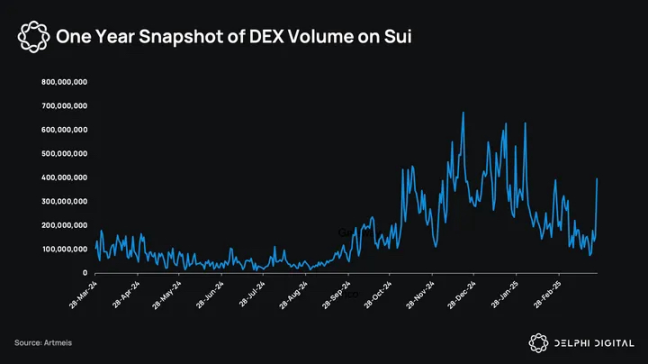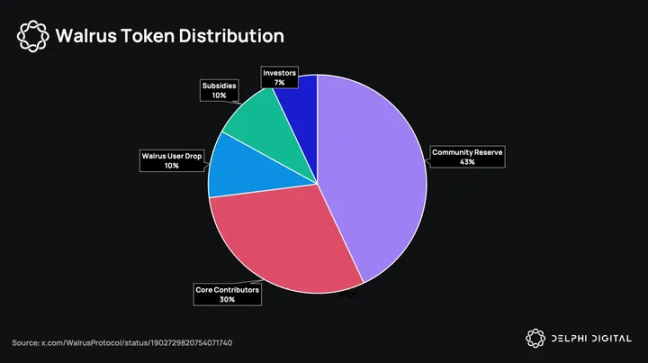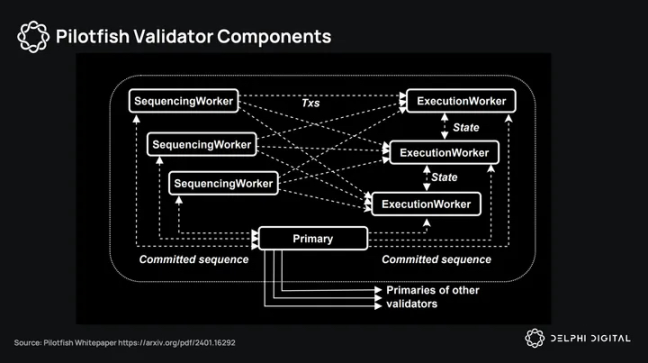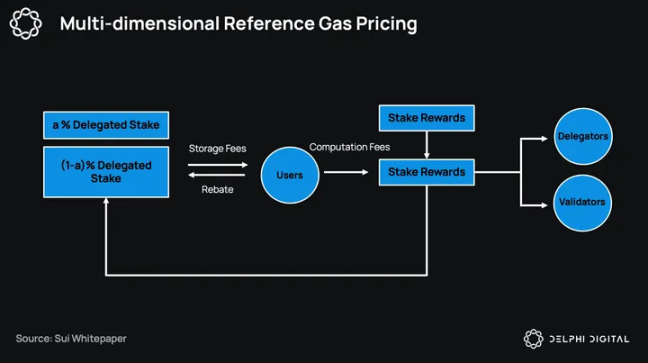Author: Delphi Digital
Compiled by: Glendon, Techub News
Since Delphi Digital last delved into the architecture, ecosystem, and tokenomics of Sui, the network has completed a series of key upgrades in its infrastructure and application stack. In this follow-up report, we will analyze the key developments in its ecosystem, including the construction of Bitcoin Finance (BTCfi) infrastructure, the growth trajectory of the lending protocol Suilend, and the expansion of Aftermath Finance.
In terms of infrastructure, the launch of Mysticeti v2 introduced a "Fast Path" for low-competition transactions, significantly reducing latency and rebalancing validator workloads. Meanwhile, Move VM 2.0 achieved significant execution improvements through advanced composability, region-based memory management, a modular architecture, and enhancements designed to support more complex and dynamic on-chain logic.
At the same time, Sui's scaling roadmap has also been continuously improved with the advancement of Pilotfish execution sharding, aiming for true horizontal scalability and resilient validator configurations. These improvements in Sui have been further reinforced by implementing localized object-based fee markets and MEV-aware optimizations, including prioritized transaction submissions and consensus block flows.
Ecosystem Updates
DEX trading volume on Sui has retreated from last quarter's highs, but there has been an uptick in volume following the launch of the WAL token for the decentralized storage protocol Walrus on March 27.

BTCfi on Sui
BTCfi has recently emerged as a niche market on Sui, bringing lending, staking, and yield-generating elements to Bitcoin, which has traditionally been viewed as passive collateral. According to DeFiLlama, the total locked value (TVL) in the BTCfi space has grown from under $100 million to over $4.5 billion, covering various assets including re-staking, pegged assets, and decentralized BTC.
By the end of 2024, Sui announced a partnership with Babylon Labs and Lombard Protocol to introduce native BTC staking through LBTC. LBTC is a liquid staking token directly minted by Lombard on the Sui and Cubist platforms, designed to help users manage deposits, minting, cross-chain, and staking. A few weeks later, in December 2024, Sailayer partnered with LBTC and WBTC to launch re-staking opportunities for BTC. Prior to this, the Lorenzo protocol launched stBTC on Sui, a liquid staking token powered by Babylon, aimed at aggregating BTC yields and integrating with DeFi protocols like Cetus and Navi. In early February 2025, Sui Bridge added support for wrapped BTC assets like WBTC and LBTC, and since then, over 587 BTC have flowed into Sui DeFi platforms.
So far, over $111 million in wrapped BTC has been deposited into Sui native protocols like Suilend, Navi, and Cetus.
DeFi Protocols on Sui
Suilend
Suilend is the lending protocol for the Sui ecosystem, and in less than a year of operation, its annual revenue reached $15 million in February 2024, with 70% flowing into the SEND treasury. The treasury initially received 1.2 million SUI from the "mdrop."
Suilend also launched the automated market maker (AMM) Steamm, which features an integrated money market component aimed at maximizing capital efficiency by depositing idle liquidity into the lending market. The protocol has a composable architecture that supports various quoting systems, including constant product quotes, stablecoin-specific quotes, and dynamic fee quotes based on market volatility. By allowing idle funds to earn yields in the lending market while still being available for trading, Steamm enhances capital efficiency and provides additional returns to liquidity providers through its bToken mechanism.
Aftermath
MetaStables, incubated by Aftermath on Sui, is a treasury system that allows users to deposit cross-chain or native assets to mint stablecoins like mUSD (pegged to the dollar) and mETH (pegged to ETH), with plans to launch meta-tokens like mBTC in the future. It uses oracle-based exchange rates (e.g., Pyth) for slip-free trading between treasury assets, avoiding the inefficiencies of AMM slippage and supporting the lending of deposited assets to enhance yields. The concept of MetaStables is to address liquidity fragmentation issues by promoting meta-tokens and allowing users to earn mPOINTS.
In addition to MetaStables, Aftermath has also launched Perp DEX on the testnet, a fully on-chain perpetual contract order book based on Sui.
Walrus Launch
The decentralized storage protocol Walrus launched its mainnet on March 27, 2025, completing a $140 million funding round led by Standardcrypto.
Walrus is a decentralized storage network built on Sui, designed to store various data, from NFT assets and AI model weights to blockchain archives and website content. It can also serve as a data availability layer for rollups, similar to Celestia or EigenDA. While Walrus utilizes Sui for metadata and governance, it offloads storage tasks to a separate set of nodes, thereby avoiding the overhead of Sui validators.
At the core of Walrus is Red Stuff, a two-dimensional encoding protocol that enables efficient single-file encoding with robust data recovery capabilities. The system is protected by a staking-based WAL token incentive model, where nodes are rewarded for uptime and correct data handling, and penalized for failures or malicious behavior. The breakdown of WAL token economics is as follows:
- Community Reserve: 43%
- Core Contributors: 30%
- Walrus User Airdrop: 10%
- Subsidies: 10%
- Investors: 7%

Technical Updates
Sui Core Development Projects
Mysticeti V2 Update
Delphi Digital detailed Mysticeti v1 in a previous report titled "Sui Network: Unveiling the Mysteries of Monolithic Competitors." It eliminates the need for block certification by embedding submission rules directly into the DAG structure. This theoretically reduces the submission time for each block to a minimum of just three rounds of messages, shortening Sui's consensus latency from about 1900 milliseconds (Bullshark testnet) to approximately 390 milliseconds. Additionally, since each block requires only one signature, it reduces the CPU load on validators, thereby improving execution throughput and response speed.
Mysticeti-FPC (v2) expands on Mysticeti-C (v1) by introducing a "Fast Path" for transactions that do not require full consensus, particularly suitable for common cases like token transfers or NFT minting, which only involve assets owned by a single address. Mysticeti-FPC does not run as a separate protocol (like FastPay or Sui Lutris) but embeds the fast path logic into the same DAG, avoiding additional messaging, redundant cryptographic operations, and consensus post-checkpoints.
Move VM 2.0 Enhancements
Sui's Move VM v2 is a foundational optimization focused on execution efficiency and system composability. Core improvements include arena allocation, package caching, and low lock contention, aimed at reducing latency under load. The speed of internal calls has significantly improved through cross-package pointer references (including system-level access).
Additionally, the virtual machine introduces a multi-stage abstract syntax tree (AST) for validation, optimization, and execution, as well as linking logic for cross-package virtual table resolution and updates, simplifying modular development. Early benchmarks show speed improvements of 30% to 65% across various execution paths. This will enable Sui to scale to more complex, high-throughput use cases with Move VM v2.
Execution Sharding with PilotFish
Pilotfish is a horizontally scalable execution engine that breaks the bottleneck of Sui's original single-machine execution model. Traditionally, Sui validators are monolithic, processing consensus, data fetching, and state execution on a single machine, limited by vertical scaling in computation, memory, and storage.
Pilotfish decomposes this whole into three distinct layers:
- Primary: The central coordinator handling transaction ordering and consensus;
- Sequencing Workers (SWs): Scalable nodes responsible for extracting and routing transactions;
- Execution Workers (EWs): Horizontally distributed machines that store shards of on-chain state and perform actual execution.

Pilotfish's sharding workload distribution:
- Each transaction is routed to a specific sequencing worker.
- Each on-chain object (i.e., state) is mapped to a specific executor.
Transactions that require access to objects across multiple shards are resolved through coordinated data exchange, a pull-based model where executors request remote state on demand. This maintains consistency without sacrificing parallel execution and is closely integrated with Sui's lazy consensus design, which reaches consensus based on batch metadata rather than complete transaction data.
This allows for parallelism to be achieved without shared memory, enabling compute-intensive workloads to scale linearly with the increase in available hardware. Benchmark tests show that Pilotfish can achieve up to 10 times the throughput with 8 EWs compared to baseline execution engines.
Horizontal scaling can pave the way for true resilience in validator infrastructure. Unlike vertical scaling, which is strictly limited by hardware costs and configuration delays, horizontal scaling allows validators to elastically spin up general-purpose servers (e.g., 32-core servers on AWS or GCP) to handle demand spikes. If traffic persists, validators can migrate to more cost-effective bare-metal servers.
The impacts are threefold:
- Validator operations become hardware-agnostic: no special high-end configurations are required;
- Infrastructure configuration becomes elastic and programmatic: automatically scaling based on demand;
- The design space opens up for Sui-native innovations, such as package-specific fee markets or priority queues, enabled by Sui's object-centric state model.
This will make Sui one of the few execution environments capable of absorbing consumer-grade transaction throughput without increasing centralization or affecting latency.
Implementation of Object-Based Local Fee Markets
Sui employs a multi-dimensional reference Gas pricing mechanism, dividing fees into two main components: computation fees and storage fees. So, how does Sui's local fee market operate within the Sui object environment?

Sui has implemented an object-based local fee market mechanism that, unlike Ethereum, is more similar to Solana's fee structure. Sui sets fees based on specific demands associated with individual objects or assets. Each asset or application on Sui has its own independent fee market, allowing for local adjustments without impacting the entire network.
In contrast, Ethereum operates a unified global fee market, where each transaction can lead to overall network congestion, causing fees to rise across the entire chain during periods of increased demand. Similarly, Solana uses a localized fee market system that adjusts fees around specific contentious state objects or accounts.
Sui further extends the localization concept by directly associating fees with "objects" rather than "states." By linking fees to specific objects, Sui can process transactions involving different assets in parallel, avoiding fee interactions or congestion spillover. This isolation means that even if other applications on Sui are highly active, new applications can still achieve a high level of activity. For example, popular trading pairs on a DEX can independently adjust fees based on their own demand. Thus, Sui's object-level granularity in local fee markets is fairer to its user base and more efficient for its developer community.
Canonical Balance Accumulators
Sui's Canonical Balance Accumulators adopt an object-based design, where balances are on-chain Move objects. These objects are not abstract concepts within contracts but are independent, verifiable state objects. This setup enables transaction-level parallelism, as execution relies solely on access to specific objects rather than shared global storage.
Ethereum uses centralized mappings in ERC-20 contracts to track balances. Each transfer triggers shared state, which hinders parallelism and binds composability to contract-specific logic. Each token has its own implementation, often leading to integration edge cases.
Solana handles balances through token accounts, which aids in parallel execution. However, developers must pre-specify all accounts for each transaction. This creates friction in building modular systems and limits flexibility under dynamic conditions.
Sui simplifies this process. Standardized balance objects and managers like "BalanceManager" provide a clear way for protocols to track and modify balances without owning state. Execution is horizontally scalable by default, and balance logic can be ported across modules without being wrapped in custom interfaces. Building and unlocking using object-level fee markets, isolation, and composability becomes clearer without coordination overhead.
Multi-Signature Account Implementation
Sui's multi-signature implementation is based on a weighted k-of-n signature model. Each signer is assigned a weight, and when the total weight reaches or exceeds a preset threshold, the transaction is executed. This allows for flexible signing strategies, such as requiring 2 out of 3 signers or mandating that one key always signs alongside others, enabling a two-factor authentication (2FA) setup.
What sets Sui's approach apart is its support for heterogeneous key schemes within the same multi-signature. Users can mix Ed25519, secp256k1, and secp256r1 keys within a single authentication object, unlocking more composable wallet and custody designs without specialized tools.
Unlike threshold signatures that compress approvals into a single opaque signature, Sui's multi-signature openly shows which keys signed which approvals. This enhances auditability and cross-party coordination without complex multi-party computation (MPC) setups. Therefore, it is easier to reason about, rotate participants, and is natively compatible with Sui's transaction model.
MEV Developments on Sui
Priority Transaction Submission
At the execution layer, Sui addresses conflicts on shared objects through a Gas-based priority mechanism. Priority Gas Auctions (PGAs) serve as the primary coordination layer. Since Sui's execution is object-centric and transactions modifying the same object must be serialized, PGAs act as a congestion pricing mechanism, particularly useful in object hotspots or DEX fluctuations.
SIP-19 introduces a soft bundling mechanism that submits off-chain assembled transaction groups as a single unit. This enables reverse auctions (e.g., via Shio), where seekers can bid to attach their transactions to bundles with high execution probabilities.
SIP-45 adds consensus amplification features. Transactions with Gas prices exceeding kx RGP will be submitted multiple times by different validators, effectively amplifying their presence in consensus. This reduces volatility caused by validator desynchronization or leader rotation and ensures that Gas prices accurately reflect inclusion priority, thereby curbing spam and enhancing fairness.
Mysticeti Block Streaming
One of the most exciting upgrades underway in Sui is block streaming. Full nodes will be able to directly subscribe to consensus blocks, allowing access to pending transactions with less than 200 milliseconds of latency before they are finalized. This reduces the advantage of co-located seekers and democratizes access to MEV opportunities.
Unlike off-chain relays, it is permissionless and open. It also provides third-party nodes with a deterministic view of transaction ordering, allowing speculative execution, arbitrage, and buyback logic to run almost in real-time.
Time-lock encryption is being planned to help Sui address harmful MEV, and an MEV revenue distribution model is also being explored. Incentives will benefit validators, applications, and users, not just seekers.
DevX Updates
Sui has made several DevX improvements. The Move Registry formalizes dependency management by supporting the naming and versioning of on-chain packages, eliminating fragile links based on addresses. Key frameworks and libraries are being open-sourced and provided with registry support, enabling developers to write and upgrade applications securely. Additionally, Sui offers programmable transaction block (PTB) replay and Move tracing capabilities to provide deep debugging support, allowing developers to step through transaction execution and pinpoint failure states in multi-call flows.
Conclusion
Sui has had several highlights in the last quarter. Mysticeti v2 and Pilotfish are not just routine upgrades; they will change how Sui handles transactions under load and how validators operate their infrastructure. Move VM 2.0 also brings many improvements for developers building modular applications. Together, these enhancements drive Sui towards a direction that can truly support high-frequency use cases without increasing coordination overhead.
In terms of the ecosystem, BTCfi is clearly becoming a wedge and may attract institutional interest. Protocols like Suilend and Aftermath are experimenting with new primitives that are natively compatible with Sui's architecture, such as object-based stablecoins, AMM lending hybrids, and meta-tokens. The interesting part now is to observe how the fee market performs during demand surges, whether MEV tools like soft bundling or block streaming will be adopted by seekers, and how infrastructure like Pilotfish will change validator economics in practice.
Additionally, Delphi Digital has noted an increase in institutional interest, with Canary Capital submitting an application for the Canary SUI ETF in the first quarter. Previously, it was reported that financial institutions such as Grayscale, Franklin Templeton, VanEck, Libre, and Ant Group are also involved, all launching related investment products on the Sui network, ranging from tokenized funds to exchange-traded notes (ETNs).
免责声明:本文章仅代表作者个人观点,不代表本平台的立场和观点。本文章仅供信息分享,不构成对任何人的任何投资建议。用户与作者之间的任何争议,与本平台无关。如网页中刊载的文章或图片涉及侵权,请提供相关的权利证明和身份证明发送邮件到support@aicoin.com,本平台相关工作人员将会进行核查。




